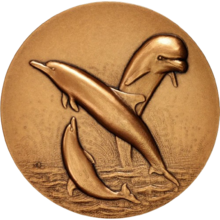Order of Satavia
| Order of Satavia | |
|---|---|
 Medal of the Order of Satavia | |
| Awarded by the President of Satavia | |
| Type | National order |
| Established | 1 October 1927; 97 years ago |
| Country | |
| Motto | Amor patriae ("Love of the fatherland") |
| Eligibility | All living persons |
| Awarded for | Achievement, merit or service to the Satavian Federation, its people, humanity, or God |
| Status | Currently constituted |
| Founder | Richard XIII |
| Grand Master | President of Satavia |
| Classes |
|
The Order of Satavia is the national order and highest honour in the orders, decorations, and medals of Satavia. It can be awarded to all living persons, regardless of nationality, and has both general and military divisions. The order was established on 1st October 1927 by Richard XIII, King of Estmere and the Lands Beyond the Sea on the advice of the government of Edward Limes. Before the establishment of the order, Satavian citizens (who were also Estmerish subjects) were awarded Estmerish honours, on the advice of the Governor-General of Satavia. From its establishment until 23 September 1936, when Satavia achieved independence from Estmere, Satavian citizens remained eligible for Estmerish honours.
History
The Order of Satavia was established on 1 October 1927 by letters patent of Richard XIII of Estmere and the Lands Beyond the Sea on the recommendation of the Governor-General of Satavia, Lord Ashgrove. Ashgrove was acting on the advice of Prime Minister of Satavia Edward Limes, whose 1927 electoral campaign had been fought on the issue of Satavia's relationship with Estmere. Limes' Liberal Party had been committed to independence since the 1919 general election, and Limes, a fanatical republican, had promised to begin the process of achieving independence if elected; he described such a process as a "long and winding road" during a speech he made at the University of Port Hope on the 12 July 1927. After his election in August 1927, Limes created the Exploratory Committee for Satavian Honours which proposed its findings in mid September of that year.
The order, as proposed to Edward Limes by the exploratory committee was accepted with few complaints by Limes and the Cabinet of Satavia; however, several objections were raised to the criteria under which the proposed order would be awarded. The original criteria for its award stated that it was awarded for:
Achievement, merit or service to the Dominion of Satavia and its people, God or His Majesty the King
Many of Limes' cabinet were uncomfortable with the order being awarded based on services to "God or His Majesty the King", and the Cabinet were successful in removing references to services rendered to the King. However, largely due to the pressure of the Satavian Reformed Church, services to God remained a reason for the awarding of the Order of Satavia (and continues to be a basis for awarding the honour to this day). Additionally, the original design for the insignia of the order included the then-Coat of Arms and Crown of St Edward, which cabinet rejected, resulting in a hasty re-design which instead simply featured Pelham river dolphins as its central motif, with no topping crown.
With Satavia's independence in 1936, the level of Knight/Dame became defunct, although was never officially abolished. The Grand Master of the Order, who is the Chairman of the Appointments Committee, was held ex officio by the prime minister from 1936 until 1941, when this position was passed over to the President of Satavia. Between 1939 and 1976, during the existence of the Republic of Satavia, the National Party awarded some 3,000 honours. Following the restoration of democracy in 1976, 2,165 of these honours were investigated and cancelled, mostly by the governments of Eric Edwards and Leander Kokkinakis.
Grades
Nomination and appointment
Eligibility
Forfeiture
Precedence
Recipients
Notes
- ↑ The level of Knight/Dame remain constituted but are defunct, the final awarding of this level having taken place on 23 September 1936 with the Independence Honours List